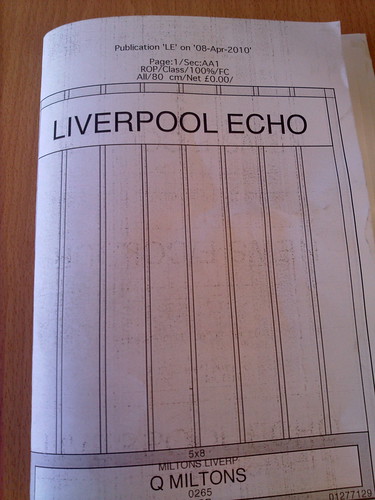
...the chances are you've brushed up against newsdesk or page design in a newsroom at some point. Everywhere I've worked it's been called something different - The Book, The Plan, The Dummy, the Flatplan - but recently I've started wondering if it should be called The Box, because we think inside it.
One of the all-consuming parts of a news editor's day (and a reporter's too, since they are the ones providing the copy) is filling the paper.
Leads and photos aren't necessarily the most difficult part of it either; there may be plenty of good newsworthy things being written up but that takes time.
And then there's the other content that fills the page - your anchors, hampers, basements etc (these also have myriad names depending on which newsroom you're in) - which always runs short.
This means that the Book is one of the things everyone thinks about - we can't help it; you want to know how many pages it has (a small Book offers its own challenges), how heavily added is it, and what the colour options are. Which means the HOW of filling a newspaper can become more absorbing and demanding than the WHAT. Content may like to think its king but, as far as most people working in print are concerned, Deadline is sovereign over all.
God it depresses me; I hate the Book and all its constraints with a passion. It can dictate when your article runs (too many ads, no decent spreads, not enough colour, too few good right-hand display pages etc etc and, indeed, etc), and stifle creativity - yes, print headlines can be awesome but I'd rather have compelling content than a clever header, plus there's nothing inspiring about knowing you have space for 350 words and one upright pic.
What I'd like to do is plan backwards. So you start thinking how you want to tell the story before you think about the platform.
It's easier online, of course. There is no book, plan or dummy other than the site template; there's no constraint on how much you can write (we've all had articles that could have run to 1,500 words only to learn there was space on the page for 800), how many photos you can use with it (in print, even a double-page spread only gives you around six photos, maybe two of which will get a display, to play with) and no 'the headline won't fit' woes. But there is the option for:
- Video
- Podcasts
- Photo galleries
- Maps
- Linking
- Chunked articles
- Forums
- Geo data
- Search
- Tagging
- Interactive charts/graphs
- Live tweets
- Live streaming
- Live blogs
- Social media
- Reader comments
- Blogs
- Interaction
- Conversation
- Soundslides
- Information sharing
In these days of slashed newsroom numbers, achieving even a handful things off the above list can be a big ask - few newsdesks have the capacity to operate with all reporters working on a single story a day, albeit told in multimedia ways. It's far more effective to have them working on multiple articles, with shovelware online content. Isn't it?
Actually, I think not. Newspapers that view the website as a place for reverse-publishing articles are settling for short-term solutions that won't last the course. Multimedia storytelling is vital to engage online audiences - 1,500 word features with multiple page breaks to boost page view counts are not the solution; compelling, thoughtful, interactive content is.
That's why I would love to hear the phrase 'How many words do you want?' replaced with 'How do you want this told?' Is that happening on any editorial floors in the UK's regional press yet? I'd love to know - because that really would be a converged newsroom.
*thanks, Wordle.


2 comments:
I love this.
I remember when a certain newspaper company started training up its reporters as 'multimedia journalists'. Like it was a badge to be worn with pride by specially-designated tech-friendly patrons of the word.
Even then I found it hilarious. It wasn't that long ago - yet the theory that MMJ is any different to the J of the day is profound, not to mention dotty.
We all consume from the same table of mixed content. So why should the serving of content be thought of differently? Everything needs to be offered to suit the reader, listener and viewer.
Much more on this soon, AG, but I assure you things are equally slow to be uptaken on the outside world as inside the newsrooms of our fair land.
Great points Alison, especially about thinking about how to tell the story first.
Newsrooms have these systems in place for a purpose I guess...breaking away from them is hard work - but ultimately rewarding, just look at any newspaper worth its salt in the US...
Post a Comment